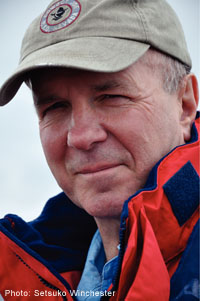Out of Many, One
Simon Winchester pays homage to the Americans who built this country’s infrastructure
Simon Winchester, an Officer of the Order of the British Empire, proudly took the oath of U.S. citizenship on the deck of the USS Constitution on July 4, 2011. Winchester’s love of America is longstanding: for decades he has traveled his adopted country, researching nearly every subject under the sun for a lengthy list of award-winning articles and books. In The Men Who United the States: America’s Explorers, Inventors, Eccentrics, and Mavericks, and the Creation of One Nation, Indivisible, he turns his attention to an often underappreciated question of American history: what is it that physically unites such a large and diverse country?
 “Unity among peoples, in a country as complicated as America, is just not an organic thing,” he writes. Indeed, the country is so varied, ethnically and geographically, that its unity, strained as it sometimes can be, is a true wonder. The constitution, the belief in the supremacy of law, and the near universal commitment to individual freedom are the philosophical cords that bind. But what keeps 314 million people in fifty far-flung states working together? For that, Winchester argues, a nation needs infrastructure, the “tangible connections – by survey lines and marks; by roads; by canals; by railways, telephone lines, power grids; and, more recently, by submerged rivers of electrons.” America has been almost as fortunate in the creation of these necessary technological links as it was in the creation of its grand experiment in democracy. A remarkable succession of dreamers and doers who either created entirely new things or improved on existing ideas forged a network that facilitates communication and commerce on a never-before-seen scale.
“Unity among peoples, in a country as complicated as America, is just not an organic thing,” he writes. Indeed, the country is so varied, ethnically and geographically, that its unity, strained as it sometimes can be, is a true wonder. The constitution, the belief in the supremacy of law, and the near universal commitment to individual freedom are the philosophical cords that bind. But what keeps 314 million people in fifty far-flung states working together? For that, Winchester argues, a nation needs infrastructure, the “tangible connections – by survey lines and marks; by roads; by canals; by railways, telephone lines, power grids; and, more recently, by submerged rivers of electrons.” America has been almost as fortunate in the creation of these necessary technological links as it was in the creation of its grand experiment in democracy. A remarkable succession of dreamers and doers who either created entirely new things or improved on existing ideas forged a network that facilitates communication and commerce on a never-before-seen scale.
Winchester has previously explored such diverse topics as the world of words (The Professor and the Madman), the first geological map (The Map That Changed the World), and the ocean that separates his home country from his home (Atlantic). The Men Who United the States is an even grander effort, encompassing more than two centuries and nearly every field of technology. He has divided this undertaking into sections aligned with the five classical elements; wood, earth, water, fire, and metal. Although somewhat strained at times, this arrangement allows a roughly chronological presentation that takes the reader on a journey beginning in a world dominated by wood and explored by the likes of Lewis and Clark to today’s wonder of interconnected metal wires that support fast-as-light communication. Along the way he detours into some tangential but always fascinating stories of human courage, foibles, or just plain playfulness that keep such a potentially heavy subject light and fun.
 Several of the stories in The Men Who United the States have been told many times before and will be review material for readers with a general knowledge of U.S. history. Winchester reintroduces Lewis, Clark, and Sacagawea, retells the story of the Powell expedition on the Colorado River, and summarizes the War of the Currents between Edison and Westinghouse. But even the serious student of Americana will be unlikely to know of the first Geographer of the United States, Thomas Hutchins; a perceptive and racially progressive geologist named Clarence Rivers King; or the visionary railway engineer Theodore Judah. Winchester also reveals that it was Franklin Roosevelt, not Dwight Eisenhower, who first laid out the routes that would become the Dwight D. Eisenhower National System of Interstate and Defense Highways (though in fairness it should be noted that Eisenhower recognized the need for such roads in 1919). In these uncommon names and little-known events the book’s joy is found. If you can read the story of pilot Calbraith Perry Rodgers’s groundbreaking flight across the continental United States in a Wright Flyer named Vin Fiz (after a reportedly undrinkable soda) and not smile at the ingenuity of the American people, you need to learn to curb your cynicism.
Several of the stories in The Men Who United the States have been told many times before and will be review material for readers with a general knowledge of U.S. history. Winchester reintroduces Lewis, Clark, and Sacagawea, retells the story of the Powell expedition on the Colorado River, and summarizes the War of the Currents between Edison and Westinghouse. But even the serious student of Americana will be unlikely to know of the first Geographer of the United States, Thomas Hutchins; a perceptive and racially progressive geologist named Clarence Rivers King; or the visionary railway engineer Theodore Judah. Winchester also reveals that it was Franklin Roosevelt, not Dwight Eisenhower, who first laid out the routes that would become the Dwight D. Eisenhower National System of Interstate and Defense Highways (though in fairness it should be noted that Eisenhower recognized the need for such roads in 1919). In these uncommon names and little-known events the book’s joy is found. If you can read the story of pilot Calbraith Perry Rodgers’s groundbreaking flight across the continental United States in a Wright Flyer named Vin Fiz (after a reportedly undrinkable soda) and not smile at the ingenuity of the American people, you need to learn to curb your cynicism.
The Men Who United the States is a work of history, presumably apolitical, but Winchester can’t help but do a little preaching here and there. He makes a point of noting, for example, that although a mistrust of big government is understandable, it was government action that built much of the nation’s infrastructure. Government agencies, he writes, “could design and build vast systems of roads, bring electricity to isolated farms, sponsor exploring expeditions involving thousands of scientists, and order into the unknown men like Lewis and Clark and demand they ascertain the shape and nature of the nation.” And although he allows some credit to the men who took personal initiative, whether for glory or gold, to bring people together, his narrative as a whole provides remarkable proof that in America it has always required a fusion of government largess and private enterprise to produce the progress for which the nation is rightly famous. This tension between the public and private good is in America’s genetics, founded as it was by people of great public conscience and burning personal ambition. And as a chronicle of the success of this unique system The Men Who United the States will bring new appreciation of the marvel that is these United States.
Simon Winchester will discuss The Men Who United the States at Parnassus Books in Nashville on November 7, 2013, at 6:30 p.m.


